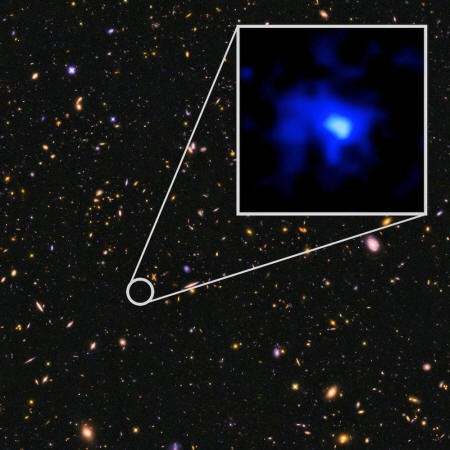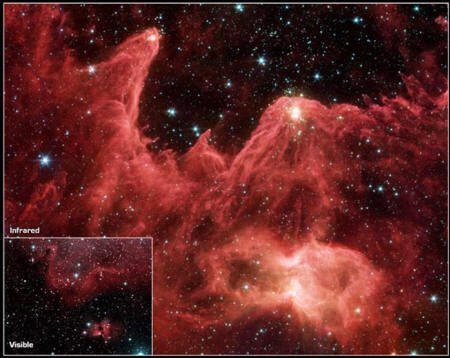|
imaged here by the Hubble Space Telescope. New measurements taken at the W. M. Keck Observatory show that the galaxy lies about 13.1 billion light years from Earth. Credit: NASA, ESA, P. Oesch and I. Momcheva (Yale University0), and the 3D-HST and HUDF09/XDF teams.
A galaxy far, far away - farther, in fact, than any other known galaxy - has been measured by astronomers.
The galaxy EGS-zs8-1 lies 13.1 billion light-years from Earth, the largest distance ever measured between Earth and another galaxy.
The universe is thought to be about 13.8 billion years old, so galaxy EGS-zs8-1 is also one of the earliest galaxies to form in the cosmos. Further studies could provide a glimpse at how these early galaxies helped produce the heavy elements that are essential for building the diversity of life and landscapes we see on Earth today.
EGS-zs8-1 is one of the brightest objects observed in this region, which is around 13 billion light-years from Earth.
The authors of the new research say other galaxies likely lie at similar distances or even further from Earth, but they are too faint for scientists to measure their exact distance.
To measure the separation between Earth and a far-off cosmic object, astronomers often look at how quickly those objects are moving away from Earth.
The universe is expanding; space itself is growing like a balloon or a loaf of bread in the oven. Objects in the universe thus move away from each other, like raisins in the bread dough.
As these objects move away from Earth, the light they emit becomes shifted. The more far-flung an object is, the faster it appears to move away from Earth, and the more the light is shifted.
So, by measuring the degree of shifting - known as "redshift" - astronomers can also measure distance.
A higher redshift equals a larger distance, and galaxy EGS-zs8-1 has the highest redshift ever measured, according to the new research (the previous record holder has a redshift that is only slightly smaller).
Galaxy EGS-zs8-1 was originally identified by the Hubble Space Telescope and the infrared Spitzer Space Telescope, and stood out because of the unique colors it emitted. The new research used observations conducted with the MOSFIRE instrument on the W.M. Keck Observatory's 10-meter (33 feet) telescope in Hawaii.
The light from EGS has traveled a distance of 13.1 billion light-years, so the light shows EGS-zs8-1 as it was 13.1 billion years ago.
At that time, the universe was only about 670 million years old, or about 5 percent its current age of about 13.8 billion years, according to a statement from Yale. The first stars began forming about 200 million to 300 million years after the Big Bang, according to Pascal Oesch.
By combining observations from Keck, Spitzer and Hubble, the researchers say they can estimate that the stars in EGS-zs8-1 are,
But Oesch said it is difficult to know how old EGS-zs8-1 is compared to other galaxies at a similar distance from Earth. It is, however, one of the oldest galaxies yet measured.
The new observations also show that EGS-zs8-1 is forming stars 80 times faster than the Milky Way.
In addition, the still-growing galaxy has,
The unique colors observed in EGS and other early galaxies by the Spitzer Space Telescope (below) present questions about what took place in these primeval environments.
According to the statement, these colors could have been caused by the rapid formation of massive, young stars that interacted with the primordial gas in these galaxies.
Oesch said further study of the galaxy could reveal the types and amounts of heavy elements that formed there.
In addition, the new observations provide,
The research (A Spectroscopy Redshift Measurement for a Luminous Lyman Break Galaxy at Z = 7.730 using Keck/Mosfire) appeared online today (May 5) in the journal Astrophysical Journal Letters.
|


